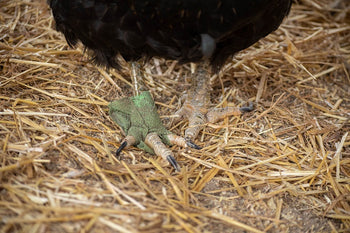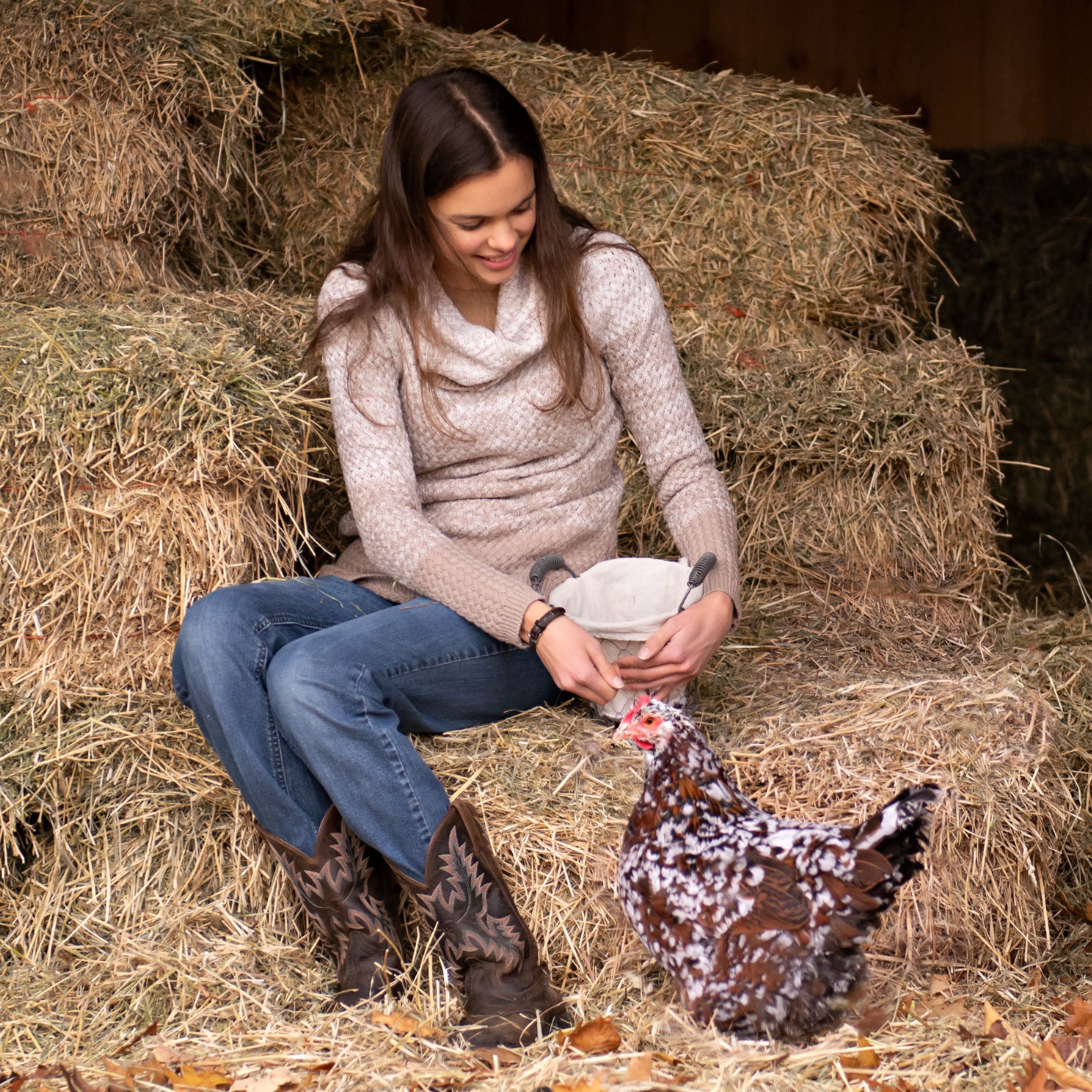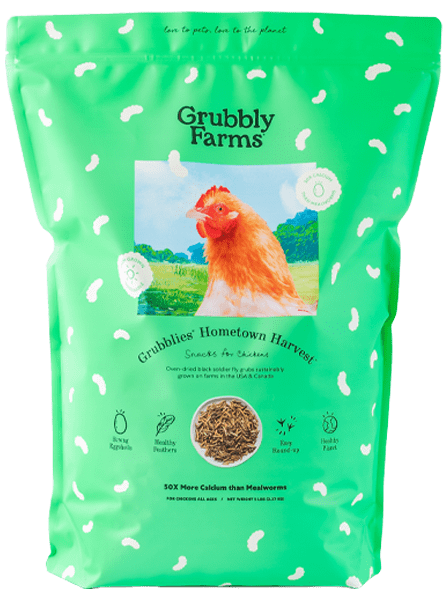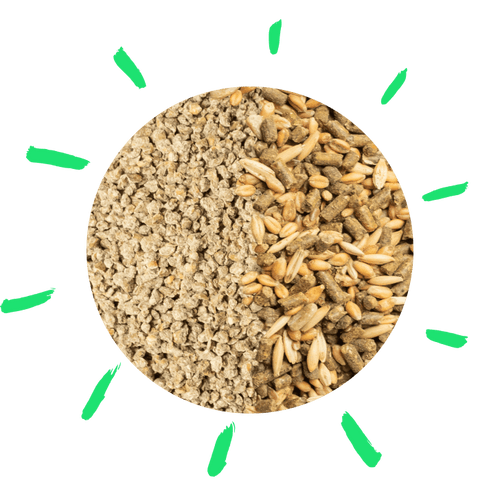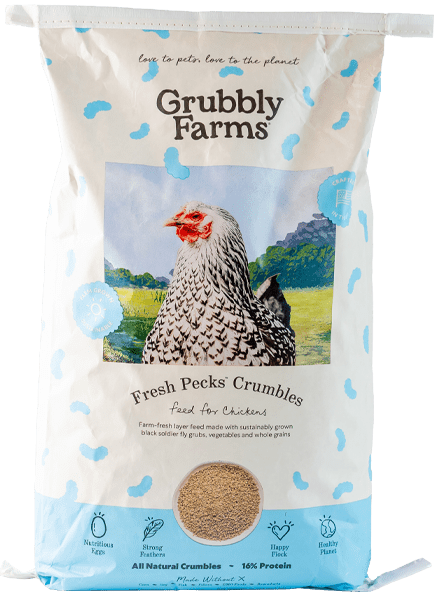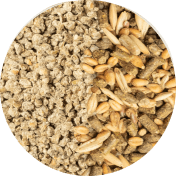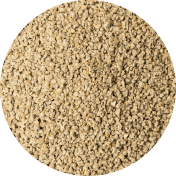External parasites are nearly impossible to avoid when raising a backyard flock. Thankfully, as long as you do regular health checks and use preventive measures, you can help keep your flock parasite free. One of the most common external parasites to affect chickens are mites. You should know how to recognize, treat, and prevent chicken mites to keep your backyard flock healthy and mite infestation free.
What Do Chicken Mites Look Like?
Chicken mites are extremely small bugs, or external parasites, that can live both on and off their host. The general shape and color of these small parasites varies depending on the species of parasite. The best way to identify different species of external parasite is by the shape, color, or number of legs the parasite has.
Here are three common mites that can affect chickens and what they look like:
- Northern fowl mites - dark in color, pale if young or if they haven’t fed recently, eight legs, extremely tiny and barely visible with the naked eye
- Red mites - oblong shape, bright red especially after feeding, eight legs
- Scaly leg mites - type of burrowing mite, not visible to the naked eye, easily diagnosed by signs and symptoms
Another external parasite that can live on chickens is lice. Lice are larger than mites. They only have six legs, are longer in shape, and are often pale in color.
Mites spread to chickens through direct contact. Chickens can get mites from new birds being added to the flock who have external parasites. They can also get external parasites from wild birds, which can be a concern for free-range flocks or if wild birds have access to your flock’s feed or enclosure. Once one chicken has external parasites, the parasites spread quickly to the whole flock.
Mites can live for up to three weeks without a host. They can burrow into cracks and crevices of coops and equipment and will stay in the environment until they can get back onto a host (a chicken).
Types of Chicken Mites
The three most common chicken mites to affect chickens are northern fowl mites, red mites, and scaly leg mites.
- Northern fowl mites feed on a chicken’s blood and are most common in northern regions since they prefer cool weather. They can live both on a chicken and in the chicken coop. They are one of the most common external parasites to affect backyard flocks.
- Red mites also feed on a chicken’s blood but are more common in warm, humid climates. They are not as common in the United States and can also live on and off a chicken.
- Scaly leg mites are tiny burrowing mites that live under the scales on a chicken’s feet and legs. They feed on the keratin found under the scales and are quite common.
Thankfully, most chicken mites have a short life cycle. They live, reproduce, and die all within about a week to ten days. However, they can be hard to completely get rid because most treatments don’t kill the parasite’s eggs, also called ‘nits’. A treatment can kill any live parasites, but the parasites can return once the nits hatch.
A parasite infestation will negatively affect a chicken’s health. Mites can cause anemia since they feed on a chicken’s blood and, if an infestation is left untreated, it can be fatal. Scaly leg mites are not known to be as fatal, but they can cause extreme discomfort for a chicken and can cause loss of toes.
Signs That a Chicken Has Mites

Chicken mites can be hard to recognize until a serious infestation has occurred. It is always a good idea to do regular health checks on your flock so that you can catch chicken mites before they become a serious problem. Here are some signs to watch for that might indicate your flock has external parasites:
- Dirty vent feathers
- Pin size holes in flight feathers
- Decreased egg production
- Excessive preening
- Raised scales on the feet & legs
- Debris under the scales on the feet & legs
- Limping
- Parasite egg masses at the base of feather follicles
- Live parasites
External parasites can cause chickens to preen their feathers more than normal to relieve the itchy feeling they can get from the creepy, crawling parasites. Egg production may also decrease or stop altogether if the external parasite infestation starts to cause stress for the hens.
The surest way to diagnose external parasites is to examine your birds for the bugs themselves. Northern fowl mites and red mites live on the skin around the vent and tail region of a chicken, under the wings near the armpit, and even in the head feathers of crested chicken breeds. If you see mites on a chicken’s comb, then you know your flock has a serious infestation of parasites and that the bugs have migrated up to the head feathers of the bird.
External parasites can cause chickens to have dirty butt-feathers since the parasites like to live and lay their eggs near the warm, moist vent region of the chicken’s body. The mite egg masses can often collect debris and cause droppings to stick to a chicken’s vent feathers.
Mites that live under or around the wing region of a chicken will cause tiny, pin-sized holes to appear in a chicken’s flight feathers. You can examine a chicken’s wings for mite holes by gently fanning the feathers out and holding them up to a light to look for tiny holes.
Scaly leg mites can easily be diagnosed by examining the feet and legs of your chickens. Scaly leg mites cause raised scales on a chicken’s feet and legs. You may also notice that the scales look like they have debris clogged underneath them or are oozing out keratin as the parasites feed. The raised scales can cause leg discomfort and can lead to limping. An infected chicken may also try ‘preen’ its legs to relieve the irritation caused by the mites.
How to Check for Chicken Mites
Chicken mites are extremely small and often barely visible to the naked eye. Mite infestations are often easier to identify since egg masses have built up and the parasites will be regularly feeding, making them appear larger and darker in color. However, once a parasite problem reaches the infestation stage, it is more dangerous to your flock’s health and harder to treat.
The easiest place to examine a chicken for external parasites is around the vent region, or amongst all those fluffy butt feathers! Most of the time you can part the feathers about an inch above the vent and find a clear patch of skin where there are no feather tracts. Examine that patch of skin for crawling parasites.
You can also use the tape trick to try and get a sample of external parasites if your birds are infested. Use a piece of tape and stick it against the base of the feathers around a chicken’s vent. Don’t stick the tape on the chick’s vent. Gently pull the piece of tape away and examine it for any parasites that got stuck to the tape. If you have a microscope at home, you may find it fascinating to examine the small bugs under the microscope. Microscope examination can help you accurately identify what type of chicken mite your flock is dealing with too.
Another way to check for a mite infestation is to examine the chicken coop. The mites will be most active at night around the roosting area since this is when they can come out and easily feed off of the chickens. Use a flashlight to look for tiny, dark, crawling bugs on the roosts. You can also stick a sharp blade into any cracks or crevices around the roosts. If the blade comes out with red smears, then you know you crushed some mites that had just been feeding. Wiping a white cloth or white piece of paper along the roosts is another way to check for red smears which indicate feeding mites.
Chicken Mite Treatments
If you have diagnosed a might infestation in your flock, you will want to start treatment right away. The longer the parasites are left untreated, the more they can grow in number. Each individual mite lays an egg mass that can hatch hundreds of more mites, allowing the parasite population to grow exponentially and leading to serious health concerns for an infested chicken.
Chicken mite treatments can range from all-natural approaches to synthetic drug treatments. For serious infestations, drug treatments will be your best choice to treat the parasites as quickly and effectively as possible before they cause more damage to your flock. If you catch the chicken mites before they become a serious infestation, some simple all-natural treatments may get rid of the parasites effectively.
Here are some common chicken mite treatments:
Diatomaceous Earth
Diatomaceous earth is composed of the hard exoskeletons of diatoms. Diatom exoskeletons slice external parasites and dehydrate them, which can be an effective way to kill off live chicken mites. However, diatomaceous earth is very fine and dust-like, which can irritate the eyes and respiratory system of both the chicken being treated and the handler. If inhaled in large quantities, the sharp diatoms may cause lung damage. When spread around the chicken coop, diatomaceous earth can make the coop litter very dusty. Diatomaceous earth only kills live parasites and will not kill nits.
Garlic Juice
Garlic juice is an all-natural external parasite treatment that can be effective against mild parasite infestations when used diligently and correctly. To create a garlic juice spray treatment, mix 1 ounce of 100% pure garlic juice into 10 ounces of water. You will need to spray the solution on infected birds every other day. Shake the bottle periodically as you are applying the spray to keep the garlic juice sufficiently mixed. It may take up to three weeks of consistent application to treat the chicken mites.
Permethrin
Permethrin is a common chemical treatment for chicken mites. It can be used in a chemical liquid form or a powder form. Permethrin can be applied directly to the infected birds and used in the chicken coop, however, permethrin is highly toxic to cats. If you have a cat you will want to use extreme caution to prevent your cat from being exposed to the chemical. Permethrin 10% has no egg withdrawal period for laying hens.
Flea & Ticks Sprays & Dips
Flea and tick sprays and dips developed for cats and dogs have also been used to treat chicken mites in backyard flocks. However, most flea and tick sprays and dips have NOT been approved for use on food animals, like chickens. If using one of those treatments, it may be a good idea to implement an egg withdrawal period. Most flea and tick sprays and dips must be reapplied until all parasite egg masses have hatched since the treatments only kill live bugs but not unhatched eggs.
Spinosad
An extremely effective treatment for chicken mites is Spinosad. Spinosad can be found in name brand products like Elector PSP. It is a safe parasite treatment to use on food animals (like chickens) and has no egg or meat withdrawal period. To create a treatment spray, you will need to mix 9ml of Spinosad per 1 gallon of water. The treatment can be applied directly to the infected birds and can be sprayed around the chicken coop without having to remove any of the coop litter. Just make sure you remove your flock’s food and water before spraying the treatment around the coop. You cannot use leftover Spinosad solution since it loses its potency as it sets. The best part about Spinosad is that it kills both live bugs and nits, so reapplication is rarely necessary.
How to Apply Mite Sprays
Chicken mite treatment sprays should be applied directly to the chicken’s skin. You will want to pay special attention to areas where the mites like to congregate, such as around the vent, under the wings, and in the head feathers of crested chicken breeds.
Applying a chicken mite treatment spray is usually a two-person job. One person will need to securely hold the chicken while the other person applies the spray. The best way to hold a chicken when applying the spray is by gently gripping both of the chicken’s legs and using the other hand to steady the bird in the palm of your hand. Then flip the bird so that its back is against your chest. Once in an inverted position, you can gently tilt the bird so that its rear is facing outward and easy for the other person to access and apply the mite treatment. Treat areas such as the head and under the wings by holding the bird gently against your body while securing its legs with one hand and its wings with your other hand.
The person who is applying the mite treatment spray will need to gently part the feathers so that the spray gets directly on the chicken’s skin. When applying the spray to the head region of a chicken, be careful not to get the spray in the chicken’s eyes, nostrils, or ears. The same method of application can be used when treating chickens with diatomaceous earth powder as well.
For spray solutions that have to be diluted, such as garlic juice or Spinosad, frequently shake the bottle as you treat each bird in your flock. Shaking the bottle will ensure the solution is thoroughly mixed and that the solution doesn’t separate. Spray each area that needs to be treated very thoroughly, but don’t soak the chicken. The chicken’s skin should look wet, but its feathers should be mostly dry. You will need to treat all the chickens in your flock even if you don’t see live parasites on every bird.
You will also need to treat the chicken coop and enclosure since chicken mites can live in the environment for a limited amount of time. If the coop and enclosure are not treated, the live parasites can crawl back onto the birds and cause a re-infestation. To treat the coop and enclosure, remove as much litter as possible and remove your flock’s feed and water.
Apply the chosen mite treatment liberally within the coop and enclosure. If the treatment was a spray treatment, allow the coop to dry before putting fresh litter back down and putting your flock’s food and water back into the coop. If you are using a Spinosad treatment, you only need to remove the feed and water from the coop. You can treat the litter right along with the rest of the coop.
For all chicken mite treatments except Spinosad, you will need to retreat your flock within 5-7 days to kill off any mites that hatch from the egg masses. Sometimes you may need to re-treat your flock two or three more times after the initial treatment to kill off any mites that hatch out. It’s always a good idea to keep checking for chicken mites for two to three weeks after treating your flock so you can catch any nit hatches before they become an infestation again.
How to Treat Scaly Leg Mites

Scaly leg mites will need to be treated differently than northern fowl mites or red mites. Since the scaly legs mites only inhabit the feet and legs of a chicken, you only need to treat those areas. However, scaly leg mites do spread just as quickly as other mites, so if one chicken in your flock has scaly leg mites it’s a good idea to keep an eye out for early scaly leg mite symptoms in other chickens of the flock.
To treat a chicken with scaly leg mites, follow these steps:
- Choose one of the mite treatments from the list mentioned above. A spray treatment will be the easiest treatment to apply to a chicken’s legs and feet.
- Gently wash the chicken’s legs and feet with warm, soapy water. Don’t try to scrub off the raised scales as that can be painful for the chicken and may even draw blood.
- Gently dry the chicken’s feet and legs.
- Prepare a deep bucket or pan and fill it with neem oil. Dip the chicken’s legs and feet into the neem oil so that the oil coats the entire leg. Avoid getting any oil on the chicken’s feathers.
- Gently wipe off any excess oil.
- After the oil dip, apply the mite treatment spray.
- Allow the chicken’s legs and feet to air dry for a few minutes.
- Rub Vaseline or petroleum jelly over the chicken’s legs and feet. The petroleum jelly or Vaseline will help suffocate the mites.
As with the other chicken mites, you will need to retreat an infected chicken two or three times after the initial treatment to kill any nits (mite eggs) that hatch. Retreatment is best done several times a week to treat serious infestations.
Can Humans Get Chicken Mites?
Chicken mites can only live off of chickens and other birds. While chicken mites may crawl onto you and bite you, they cannot survive on humans. Mite bites can cause itchiness, swelling, and irritation. You should mainly be concerned about chicken mites getting on you when you are treating chickens who are seriously infested or if you are holding an infested bird for long periods of time.
How to Prevent Mites
There are several ways you can help prevent your flock from being exposed to various sources of bird mites:
- Dust Bath- make sure your flock always has access to a dust bath which enables them to prevent external parasites naturally by suffocating the parasites.
- Wild Birds & Rodents- prevent wild birds and rodents from entering the coop as they can be carriers of disease and parasites.
- Preventative Sprays- apply a parasite preventative on a monthly basis, make sure you rotate through a series of three to four external parasite preventatives to prevent parasites from developing resistance to the preventatives.
- Health Checks- perform monthly health checks on the birds in your flock to help catch external parasites before they become a serious infestation.
- Quarantine- when adding new chickens to your flock, quarantine them for 2-3 weeks and treat them for external parasites to prevent them from being carriers.
Some external parasite preventions you can use include Manna Pro Poultry Protector, diluted garlic juice, and diatomaceous earth. Don’t use permethrin or Spinosad as preventatives since those should be saved for treating mite infestations.
Chickens mainly get mites from other chickens who have are already hosts to external parasites. Wild birds and rodents can also introduce parasites into the chicken coop or enclosure. Controlling those two main sources can go a long way in preventing your flock from becoming infested with chicken mites.
Conclusion
Knowing how to get rid of chicken mites is essential for raising a healthy and happy backyard flock! Northern fowl mites and scaly leg mites are the two most common chicken mites to look out for in your flock. Doing a monthly health check on all the birds in your flock can help you catch any external parasites before they become a serious infestation. Keep your flock parasite free to ensure they stay healthy and productive!
